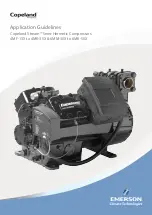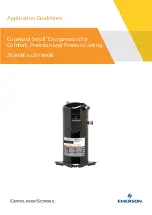
10
© 2015 Emerson Climate Technologies, Inc.
AE4-1331 R7
than the rated running amperage of the compressor
and lasts from 100 to 300 milliseconds until the rotor
starts turning. This high starting current may result in
significant “sag” in voltage where a poor power supply is
encountered. Low starting voltage reduces the starting
torque of the compressor and subsequently increases
the time the compressor is in a locked rotor condition.
This could cause light dimming or a buzzing noise
where wire is pulled through conduit. Start components
will substantially reduce start time and consequently
the magnitude and duration of both light dimming and
conduit buzzing. Specified starting components can be
found in the Online Product Information section of
www.
emersonclimate.com
.
PTC Start Components
For less severe voltage drops or as a start boost, solid
state Positive Temperature Coefficient (PTC) devices
rated from 10 to 25 ohms may be used to facilitate
starting for any of these compressors.
Electrical Connections
WARNING
Molded electrical plug (Emerson p/n
529-0060-04
or OEM equivalent) must be used with all
-1XX
and
- 8XX
bills of material.
The orientation of the electrical connections on the
Copeland Scroll compressors is shown in
Figure 4
.
Two electrical connection options are available for
these compressors. These include the “Molded Plug”
one piece push-on connection, available in certain
models; and “Quick Connect” flag termination available
only on the ZP*K3 scrolls.
CAUTION
Never operate
the compressor without the terminal box cover
installed.
Deep Vacuum Operation
Copeland Scroll compressors incorporate internal low
vacuum protection and will stop pumping (unload) when
the pressure ratio exceeds approximately 10:1. There
is an audible increase in sound when the scrolls start
unloading.
CAUTION Copeland Scroll compressors (as with
any refrigerant compressor) should never be used
to evacuate a refrigeration or air conditioning
system.
The scroll compressor can be used to pump
down refrigerant in a unit as long as the pressures
remain within the operating envelope shown in
Figure 7.
Prolonged operation at low suction pressures will result
in overheating of the scrolls and permanent damage
to the scroll tips, drive bearing and internal seal. See
AE24-1105
for proper system evacuation procedures.
Shell Temperature
CAUTION
Compressor top cap temperatures can be very
hot. Care must be taken to ensure that wiring or
other materials which could be damaged by these
temperatures do not come into contact with these
potentially hot areas.
Certain types of system failures, such as condenser or
evaporator fan blockage or loss of charge, may cause
the top shell and discharge line to briefly or repeatedly
reach temperatures above 350°F (177°C) as the
compressor cycles on its internal overload protection
device. Care must be taken to ensure that wiring or
other materials which could be damaged by these
temperatures do not come into contact with these
potentially hot areas.
Suction and Discharge Fittings
Copeland Scroll compressors have copper plated
steel suction and discharge fittings. These fittings
are far more rugged and less prone to leaks than
copper fittings used on other compressors. Due to
the different thermal properties of steel and copper,
brazing procedures may have to be changed from
those commonly used. See
Figure 8
for assembly line
and field brazing recommendations.
System Tubing Stress
System tubing should be designed to keep tubing
stresses below 9.5 ksi (62 MPa), the endurance limit
of copper tubing. Start, stop and running (resonance)
cases should be evaluated.
Three Phase Scroll Compressor Electrical
Phasing
Copeland Scroll compressors, like several other types
of compressors, will only compress in one rotational
direction. Direction of rotation is not an issue with
single phase compressors since they will always start
and run in the proper direction (except as described in
the section “Brief Power Interruptions”). Three phase
compressors will rotate in either direction depending
upon phasing of the power. Since there is a 50%
chance of connecting power in such a way as to cause
rotation in the reverse direction,
it is important to
include notices and instructions in appropriate
locations on the equipment to ensure that proper
rotation direction is achieved when the system
is installed and operated.
Verification of proper
rotation direction is made by observing that suction
pressure drops and discharge pressure rises when the
compressor is energized. Reverse rotation will result in











































